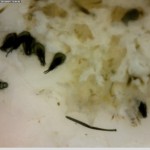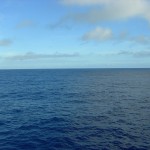I have a new post up at the SEAPLEX blog (where I put all my marine debris stuff).
A couple weeks ago I was lucky enough to go to Hawaii for the 5th International Conference on Marine Debris. (You can see my tweets at @seaplexscience, or the conference hashtag #5imdc.) This was my third time in Hawaii this year, but since the first two visits were to catch a ship and immediately leave, I’d never seen much of Hawaii outside of the Honolulu docks and Home Depot. So after the conference, my husband and I headed out for a week on the Big Island.
We decided that we had to see the Big Island’s famed green sand beach. Green sand beaches are very rare (there’s only two in US territory – this Hawaiian one, and one in Guam). The green color is caused by olivine crystals eroding out of lava flows, so you need both a nice erodible lava flow, and a relatively calm area of coast where a beach can form. There are no towns or good roads near the Big Island’s green sand beach – it’s way down on South Point, and the last 2.5 miles can only be accessed by 4-wheel drive or on foot. We like to hike and so we walked.
On our walk to the beach, I was pretty shocked at the vast amount of washed-up plastic debris that we saw in the middle of nowhere on South Point. Having studied plastic marine debris for the last three years, I was intellectually familiar with Hawaii’s marine debris problem, but seeing it with my own eyes (especially when my brain was in hiking mode) was a saddening experience. Despite a recent beach cleanup which was bagged and waiting for pickup, countless plastic items and bits were mixed with the driftwood on the black lava rock beaches.
To see lots of photos and to read the rest, head over to the SEAPLEX blog.






No! not on the green sand beach! We’re used to those beaches before the green sand beach being covered with lighters and laundry baskets and plastic bottle after plastic bottle … but the green sand beach has always been pristine.